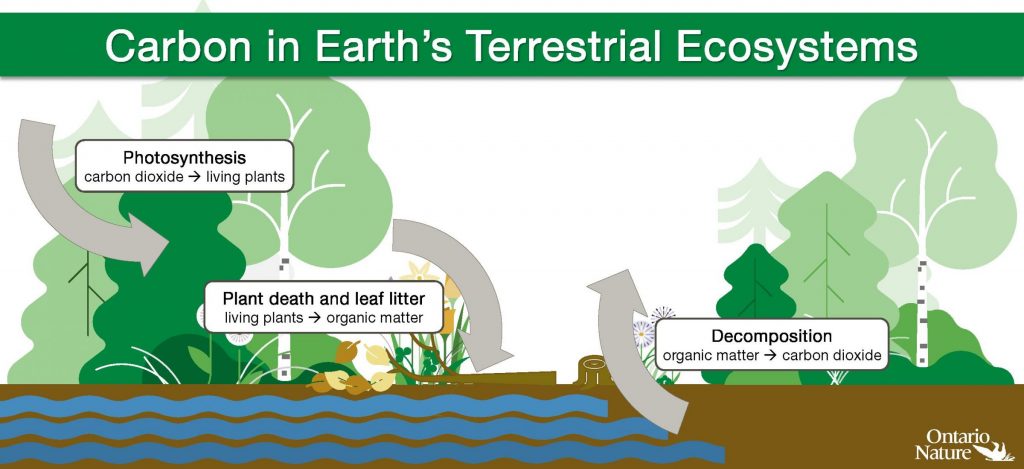Hicks Lake, boreal wetland © Kristen Setala
Climate change is caused by the accumulation of greenhouse gases (e.g., carbon dioxide, methane, nitrous oxide) in the atmosphere, trapping energy from the sun and altering temperature and weather patterns around the world. Human activity has driven the rapid accumulation of greenhouse gases by releasing previously stored carbon and other greenhouse gases into the atmosphere (e.g., by burning fossil fuels and destroying natural ecosystems). One part of the solution to climate change is to maintain and enhance existing stores of carbon (known as “carbon pools”) that comprise our wetlands and other ecosystems.
Wetlands Capture Carbon
There are five major “carbon pools” on Earth: the atmosphere, the oceans, the soils, living things such as plants and animals, and fossil fuel deposits. Carbon can move among these pools in various ways.
The Earth’s soils are a massive carbon pool, storing three times more carbon than the atmosphere and four times as much as all plants and animals. Carbon enters the soil when plants, which have stored carbon in their tissues through photosynthesis, die or drop litter (e.g., fallen leaves or branches) which partially decomposes. Left undisturbed, stable soil carbon can stay in the ground (and out of the atmosphere) for hundreds to thousands of years.
Wetlands are ecosystems characterized by seasonally or permanently waterlogged soils. Because decomposition is slower in waterlogged soils, dead plant matter can accumulate in wetland soils as “soil organic carbon” faster than it is released. Thus, wetland soils store more carbon per gram than grassland or forest soils. Cool temperatures also slow decomposition, so carbon accumulates particularly well in northern wetlands, like Canada’s boreal peatlands which contain 25 percent (150 billion tonnes) of the world’s peatland carbon.

Carbon Storage in Wetlands
In Ontario, wetlands may contain over 29 billion tonnes of carbon (Warner and colleagues, 2003, “Carbon Storage in Ontario’s Wetlands”). That’s the carbon equivalent taking every one of Canada’s 24.1 million gas-powered vehicles off the road for 1,000 years!
Much of this carbon is stored in the boreal peatlands of northern Ontario, which have accumulated deep soils rich in organic carbon over thousands of years. In fact, the world’s second largest peatland complex – the Hudson Bay Lowlands – lies largely in Ontario. These peatlands sequester and store more carbon than they release, making them a “carbon sink,” and models suggest that they will continue to do so in all but the most extreme future climate scenarios, if they are left intact.
Southern Ontario’s Significant Wetland Carbon Storage
- Wetlands across southern Ontario are estimated to store 1.3 billion tonnes of carbon – the carbon equivalent of taking Canada’s 24.1 million cars off the road for over 40 years.
- A model of wetland carbon storage in the Greater Golden Horseshoe (Canada’s most densely populated region) using World Wildlife Fund’s Carbon Map estimates these wetlands store over 134 million tonnes of carbon. Wetlands in the Greenbelt may store over 21 million tonnes!
Disturbance Releases Carbon
While intact wetlands can provide significant carbon storage and sequestration benefits, these ecosystems and their stored carbon are sensitive to disturbance.
Wetlands can be disturbed by land conversion, drainage, natural resource extraction, wildfires, climate change and other factors. When a disturbance occurs, it can cause the wetland to release large quantities of stored carbon. When this happens, the ecosystem releases more carbon than it can sequester, and it becomes a “carbon source.”
Globally, drained peatlands have been estimated to release 2 billion tonnes of carbon dioxide each year – amounting to about 5 percent of all human-caused (anthropogenic) greenhouse gas emissions.
Wetland conversion due to the settlement of southern Ontario may have reduced carbon storage by up to 700 million tonnes compared to pre-settlement estimates, and these converted wetlands could continue to release up to 1.2 billion more tonnes of carbon into the future.
Restoration Climate Benefits
In addition to protecting intact wetlands, restoring wetlands that have been degraded is critical to addressing the climate crisis with nature-based solutions.
Rewetting and other active restoration efforts in drained and degraded peatlands can return the ecosystem from a disturbed carbon source to a healthy carbon sink. That said, restoring a disturbed peatland’s ability to sequester more carbon than it releases takes decades, and restoring the carbon lost during the disturbance event may take thousands of years.
Similar trends have been observed for other types of wetlands, with the rehabilitation of degraded wetlands representing a significant opportunity to restore lost carbon storage and sequestration potential. Again, however, it takes decades to centuries to restore the full function of the ecosystem.
Primer Homepage | Carbon Storage | Flood Mitigation | Biodiversity Benefits | Additional Resources


